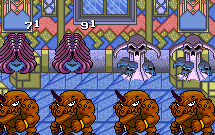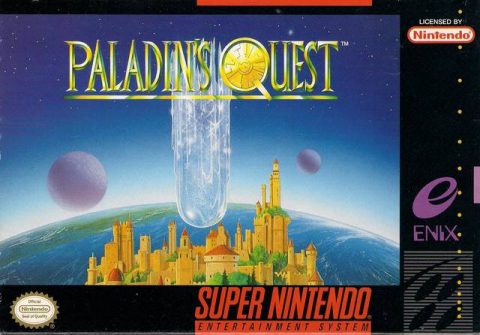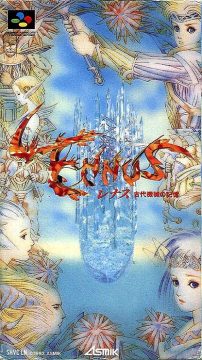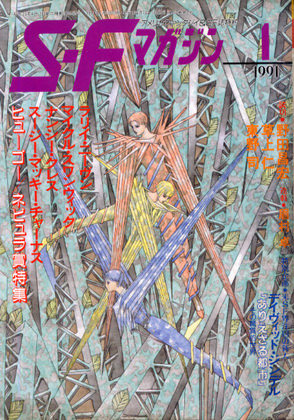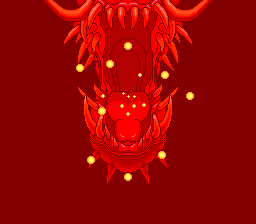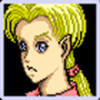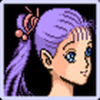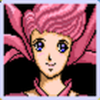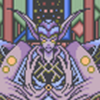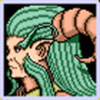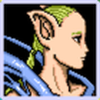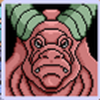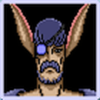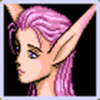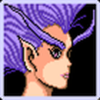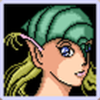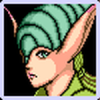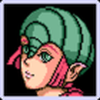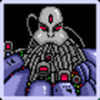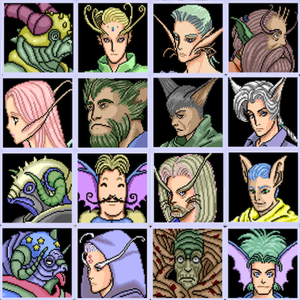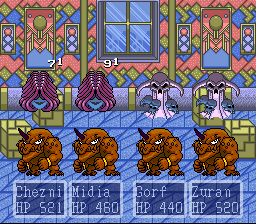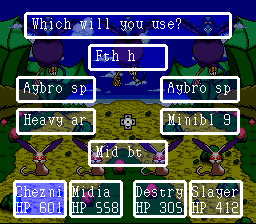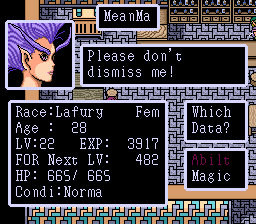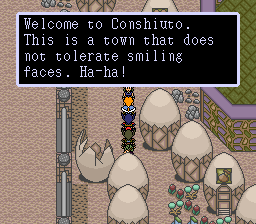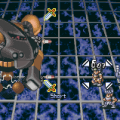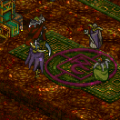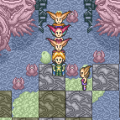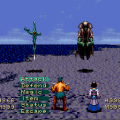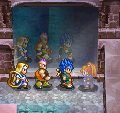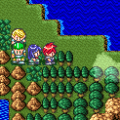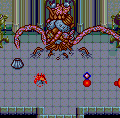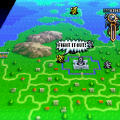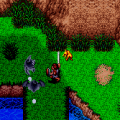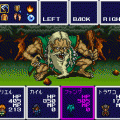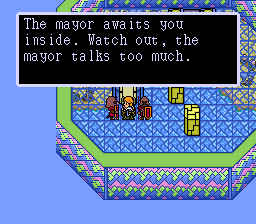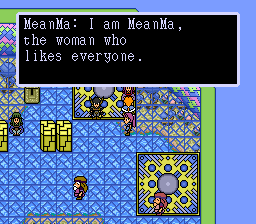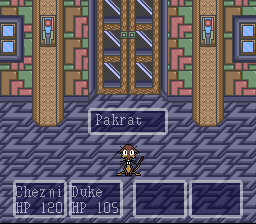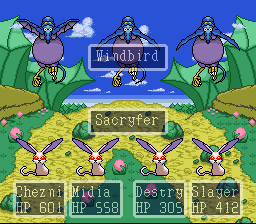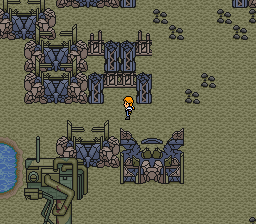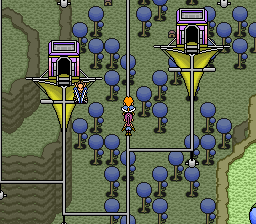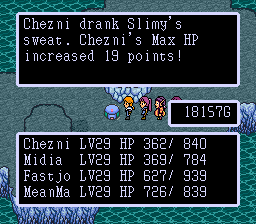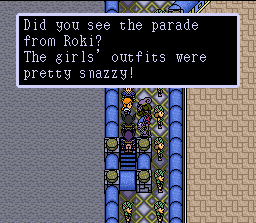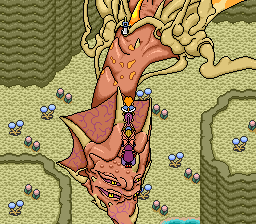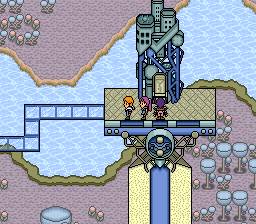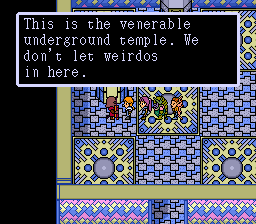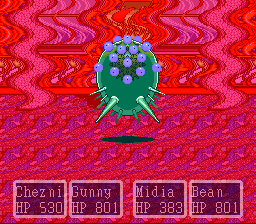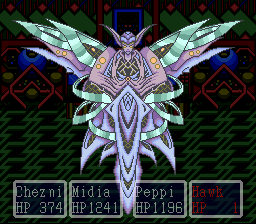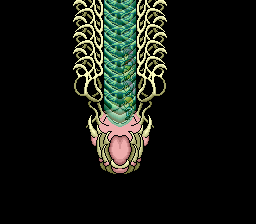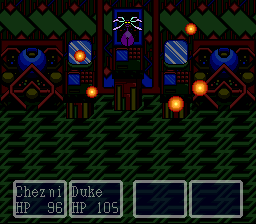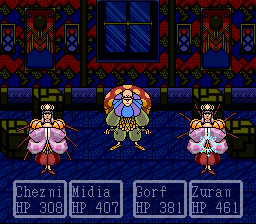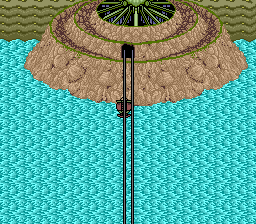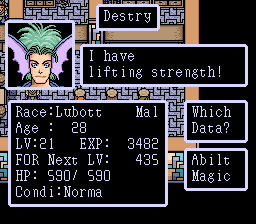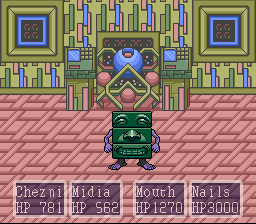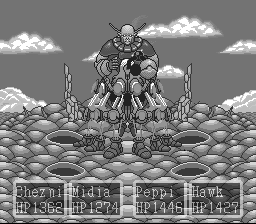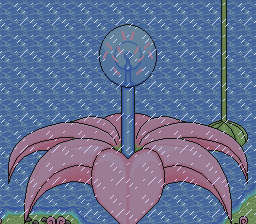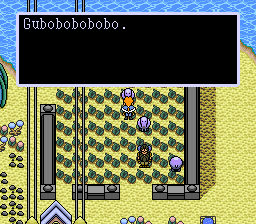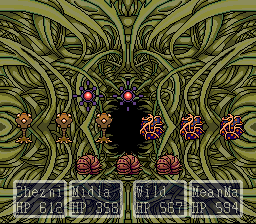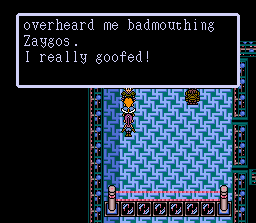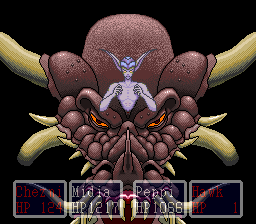- Paladin’s Quest
- Lennus II
Despite their pedigree, Enix America Inc. was one of the more peculiar localizers of the 1990s. After bringing Dragon Warrior II, III and IV westward several years after their Japanese release dates, the publisher all-but-abandoned their flagship franchise in the west, leaving its critically-acclaimed 16-bit entries to languish in Japan for the better part of two decades. Instead, they turned to translating a handful of titles from different Japanese developers that were great, like Quintet’s Actraiser; bad, like Produce’s The 7th Saga; or just plain weird, like Almanic’s E.V.O: The Search For Eden.
Copya System’s Lennus series falls somewhere between bad and weird. They’re a duo of grindy and time-consuming turn-based JRPGs, but their bizarre art design is unlike anything the genre has seen before, or ever again. The planet Lennus is a pastel-colored world of geometric trees, strange humanoid races that live in eggshell houses, and ravenous beasts of all shapes and sizes: From bug-eyed rabbits to great dinosaurs, with ladybug men in between. It gives the distinct air of 1970s French science fiction, ala Fantastic Planet or the works of the late Jean “Moebius” Giraud, something seen rarely in any video game. Lennus’ concept art was by award-winning science fiction illustrators Hiroyuki Katō and Keisuke Gotō, famed for their intensely-detailed covers of Hayakwa S-F Magazine, with monster designs handled by Shuji Imai, illustrator for Nintendo Power (including Howard and Nester, of all things). These three artists, under the guidance of the game’s writer/director Hidenori Shibao, managed to create a world that, while not always visually attractive, stood apart from its fantasy manga-style contemporaries. The music is by the prolific Kouhei Tanaka (Gravity Rush, The Granstream Saga, Tengai Makyou), and although it’s nothing to write home about, it still manages to fit the game’s mood while being pleasant to the ear.
Enix America opted not to keep the planet’s name as the game’s title, instead going with the much-more mundane Paladin’s Quest, perhaps to bring their Dragon Quest series to mind. The name ends up being a complete misnomer; there are no Paladins to be found in Paladin’s Quest! Instead, this quest is concerned with stopping a rampaging machine.
Long ago, the Great Heroes from Planet Raiga, Kormu, Sophie and Gabnid, created the ancient machine Dal Gren. Gabnid, however, drunk on power and jealous of Sophie’s love for Kormu, repurposed Dal Gren as an instrument for destruction. The heartbroken Kormu and Sophie took up arms against their former friend, slaying him and sealing Dal Gren away.
In the present day, the northern continent of Naskuot and the southern continent of Saskuot are embroiled in war. Saskuot, recently conquered by the dictator Lord Zaygos, turns its military towards Naskuot in an effort to rule all of Lennus. The game opens at an unnamed magic school in Naskuot with Chezni, a student who strives to become a great spiritualist. One day after school, Chezni is challenged by his classmate Duke to climb The Tower of Gabnid, a prominent and forbidden structure looming over the school.
When Chezni and Duke reach the top, they find a room of wires, circuits and technological marvels. Duke dares Chezni to put his hand on a palm-activated panel, but alas, the panel in question is used to activate Dal Gren! Chezni finds himself in an unwinnable battle against the powerful machine and is knocked out. When he comes to, Chezni finds the school in ruins and the headmaster, the only survivor, gives him the scolding of his life. And with that, Chezni sets out to stop Dal Gren and right what went wrong.
The mysterious console brings Dal Gren to life.
Characters
Chezni
Our hapless hero, all Chezni wanted to do was learn to be a great spiritualist, until he unwittingly activated Dal Gren, destroying the school and killing all of his peers. He sets out across Lennus to stop the machine and atone for his sins along the way. Chezni is a descendant of the Great Hero Kormu.
Midia
Chezni’s kinda-sorta love interest and a talented mage in her own right. After you rescue her from Zaygos’ forces early on, she joins as the game’s sole permanent party member. Technically this makes her the leading lady, but after joining up she hardly speaks two words for the rest of the game. Midia’s a descendent of Great Mage Sophie, lover of Kormu, so maybe it’s best not to think too much about the nature of her and Chezni’s relationship lest we get into some icky territory.
Duke
This pushy pipsqueak won’t leave you alone until you agree to climb The Tower of Gabnid with him, but as soon as Chezni activates Dal Gren he freaks out and runs away crying. Duke isn’t seen again until the very end of the game, at which point it’s revealed he’s actually…
Lord Zaygos
The wicked dictator of Saskuot who strives to conquer Lennus by force! Why? Well, the game doesn’t really get into that, he’s just an evil guy. Zaygos disguised himself as Duke to trick Chezni into activating Dal Gren, so he could harness the machine’s power to aid his quest for global domination. It’s left unexplained why Zaygos couldn’t have activated the machine himself; maybe Dal Gren only responds to Kormu’s DNA, or maybe Zaygos just likes pretending to be a child.
Fritz
Fritz is a friendly woodsman living in a cabin on Resutar Island. He’s always happy to allow travellers to stay the night in his home, until it gets blown up by Zaygos’ goblin army. Fritz won’t stand for that kind of business so he joins Chezni to rescue Midia, bringing his expertise with a bow along with him. After Midia is safe and sound, he stays behind to rebuild his cabin.
Tiger
Nephew to the elder of the Skuruu, a nomadic tribe of winged people who live in camps built upon kites high in the sky. The activation of Dal Gren had the side effect of mutating the Skuruu’s avian livestock, the Purpbirds, causing them to gain sentience and stage a rebellion against their masters. The elder sends Chezni, Midia and Tiger to kill the Purpbird leader and quash the uprising, which is actually quite sad if you stop to think about it.
Smash
This former miner is a shell of his former self when you encounter him in the underground town of Hagudo. A vein of lava erupted from the nearby mines, killing his son and putting him out of business. Although he’s the only one capable of stopping the rising lava, Smash just drinks his days away at the local pub. He won’t gain the resolve to help unless the bar’s pianist plays Godom Lullaby, a song that the pianist hates. Chezni has to find a way to get the song played so Smash can seal the vein with his mining explosives. Comically, sealing the vein causes all of the lava to disappear, revealing that all of the people and houses that were once covered have survived intact.
Grunt
The leader of the Saskuot Resistance, the only group in the country who oppose Zaygos’ rule. In an act of domestic terrorism, Grunt destroys the cable car wire you’re travelling on and kidnaps your group to his secret base. To prove you’re not with Zaygos, he has his men hold Midia hostage and forces himself into your party to rescue…
Wind
Grunt’s second-in-command, Wind was taken prisoner by Zaygos’ forces in the town of Conshuito. She doesn’t have much of a role outside of being a living macguffin, but she puts up a good fight during the brief period she’s with you.
MeanMa
Her name is somewhat deceptive, as MeanMa is quite friendly. One of the mercenaries you can hire, MeanMa is notable for being a bit too friendly; she joins for free and holds her own on the battlefield but refuses to be dismissed. The only way to ditch MeanMa is to let her fall in combat, or for her to be chased out by…
Chill
Chill is a real jerk. When you enter the town of Conshuito to rescue Wind, Chill becomes infatuated with Chezni, forcing out the mercenary in the fourth slot of your party. When you reach Wind, Chill realizes that you’re working for the resistance, spars with you, and runs off to sound the alarm and turn the town hostile. You never actually get a chance to use Chill in battle; she leaves the party if you leave Conshuito before saving Wind, so her sole purpose is to force you to fight her without a full party.
Fiery
A member of Grunt’s Resistance, Fiery is seeking vengeance for her brother, who was killed by Zaygos. She breaks you out of Zaygos’ prison and helps you destroy Noi Gren, Zaygos’ emulation of Dal Gren.
Lilie
Another optional mercenary, Lilie serves no storyline purpose but is notable for her absurd recruitment method. Lilie wants nothing more than to take part in a parade, but she wants to be properly dressed for the occasion. For an extortionate sum, she asks you to buy her a dress, accessories, a whip and boots, making her come across more like a financial dominatrix than a parade-goer. For the money you pay, she isn’t a very powerful ally, so her presence just adds to the game’s weirdness factor.
Nails
Found in the underground ancient ruins, Nails is a robot built by Gabnid ten thousand years ago. Despite his age he’s kept himself in good nick, boasting a range of powerful attacks and a high HP count. The only thing about Nails is, being a robot, he can’t gain levels and he can only heal himself through a unique, battle-only ability. He comes in handy when you first find him, but his finite potential means he’ll soon become outpaced.
Along with the characters named above, there’s a whopping sixteen additional mercenaries you can recruit to round out your party. Some of them charge money, some join for free, some are completely useless — including a conman who runs off with your money! — and some are just bizarre like the aforementioned MeanMa and Lilie. You can’t change a mercenary’s equipment, meaning everybody except late game mercs will become outpaced eventually, but making careful use of them proves to be invaluable during your trek across Lennus.
Amusingly, Headmaster Daicant and Lady Daphne are palette swaps of each other. His beard becomes her huge chin!
It’s impressive that each recruitable character has a unique portrait, which makes it all-the-more baffling that none of them have a unique sprite, instead sharing a sprite with a townsperson of their race and gender, which often look nothing like their portrait. Sometimes two separate mercenaries will even use the same sprite! The same holds true for all storyline characters, with the exception of Chezni, Midia and Duke.
Monsters are alien and numerous.
The world of Lennus is pretty inhospitable from the outset. Chezni on his lonesome isn’t much of a melee fighter, instead being handy with spells. However, there’s no MP in this game; all spells are cast from HP, so you have to keep a careful eye on your stats and make sure you don’t put yourself in a precarious position. Due to the nature of this system, there are no healing spells, nor can magic be used outside of battle, so HP is restored via the use of refillable medicine bottles or through special battle-only equipment functions. Each spell falls into one of eight categories: Fire, Water, Air, Earth, Sky, Light, Sphere and Heart. Chezni begins his quest only with affinity for fire spells, but more affinities can be purchased from special magic shops. Each affinity you earn not only grants you new spells of its nature, but it also combines with your other affinities, giving you hybrid spells that fall into both categories. Using magic regularly in battle is important, as affinities only grow in power through usage. Using hybrid spells is particularly beneficial as they strengthen two categories at once.
Selecting body parts with the D-Pad.
Paladin’s Quest‘s overall weirdness extends to its battle system, which is primarily controlled using the D-Pad. Menu commands are positioned around each cardinal direction, and choosing to attack presents you with a list of your body parts. Selecting your belt is how you down a medicine bottle (or throw a bomb, depending on what you’re wearing), but you can just as easily swing a sword as you can headbutt, kick, or hurl your body, although doing so may provide diminishing returns. Choosing when to use body parts comes into play later on when you’re equipped with gear that bestows special effects; Midia’s Crown of Sophie restores her HP when you select it, while Nails the robot can launch missiles from his head.
The quest to stop Dal Gren follows the formula laid by many of Paladin’s Quest‘s 16-bit JRPG contemporaries: Travel from town to town solving problems, working your way through vast dungeons along the way. There’s the odd dull cavern, but some of the dungeons look wonderfully inspired: The city of Jurayn is centered around the Sky Temple, a sacred tower that resembles a lily: You’ll clamber through its basement before ascending to the sky above, climbing to the top of the lily as you watch the world recede through its glass floors. Unfortunately, the unique settings do little to mitigate the fact that they’re meandering slogs through winding corridors, your walk speed as slow as the encounter rate is high.
The bizarre writing of Paladin’s Quest.
The writing and tone in Paladin’s Quest is just as bizarre as its visuals. Characters speak in a sort of stilted manner, such as a political prisoner languishing in jail lamenting that he goofed up, or an evil townsperson telling you his city doesn’t tolerate smiles. Each recruitable character also has their own status screen quote. Most are plain, but MeanMa’s plea of “Don’t dismiss me!” will probably make you smile in its weirdness. Paladin’s Quest isn’t really meant to be a parody but it does have its odd jokey moments. At one point you’ll travel through a weird cave through of parasites only to be barfed out of a dragon’s mouth, realizing what you believed to be a cave entrance was actually its sphincter. Later still, you’ll walk into a house presented in 8-bit style that holds a priest straight out of Dragon Quest, who realizes he’s in the wrong game and makes a quick exit. These comedy scenes are few and not very funny, but they lend to the game’s overarching vibe of otherworldliness.
Exploring the extraordinary world of Paladin’s Quest provided me with an entire summer of fun twenty years ago, but nowadays it’s a very hard game to return to. It’s long, grindy and the enemies have endless amounts of HP. Eventually you gain access to a wonderfully designed airship that resembles a temari ball if it took to the skies, but by that point there’s literally nothing left to do but tackle the final boss. But, despite its shortcomings, the wholly unique — and occasionally nightmarish — world of Planet Lennus stands in stark contrast to the multitude of JRPGs that settled for a more uniform fantasy setting. Paladin’s Quest still deserves to be seen, but perhaps not from start to finish.
Links:
MobyGames: Paladin’s Quest – Contains the game’s entire developer credits, among other useful tidbits.
RPGClassics: Paladin’s Quest Shrine – Home of a thorough walkthrough of the game.
Solution to Doth’s Maze – An agonizing puzzle found late in the game.
